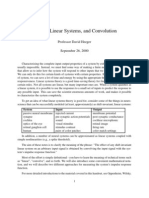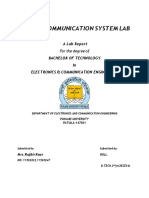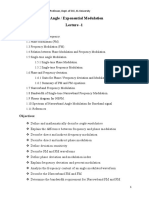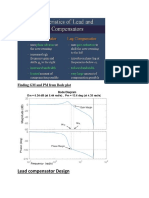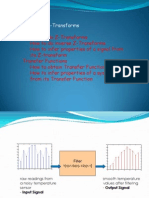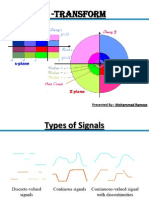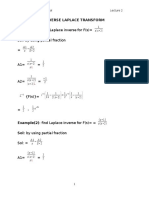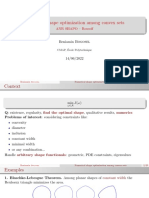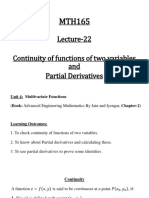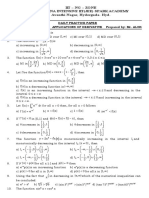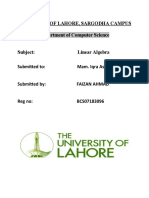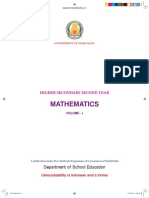AMRUTA INSTITUTE OF ENGINEERING AND MANAGEMENT SCIENCE
ENGINEERING MATHEMATICS-III
�UNIT-8
Z-TRANSFORMS
�INTRODUCTION
Z-transforms operates on the sequences of functions of a single variable defined for non negative integral values of the variable. Z-transforms serves as a tool to solve difference equations(A difference equation is a relationship between the differences of an unknown functions at several values of the indepedent variable.Difference equations arises in situations with the data consisting of only a set of values of an unknown function) Z-transforms play an important role in the analysis and representations of disrete time linear shift invariant systems.
�DEFINITION
Z-TRANFORM
If un =f(n) defined for all n=0,1,2,3..... and un=0 for n<0 then the Z-transform of un denoted by n ZT( un) is defined by ZT( un)= u n z 0 Whenever the series on the R.H.S converges it u will be a function of Z,i.e; ZT( un)= z
�PROPERTIES
d 1)ZT( nk)=-z dz
ZT(nk-1),
where k is a positive integer Proof:
n k zn ZT ( n ) =
k
0
=z
n
0
k n+1
_ _ _ _(1)
�CONTINUED
Again by definition,
ZT(nk-1)=
n
0
k 1 n
Differentiating w.r.t z,we get,
d k-1 n k 1 n z n+1 =dz ZT(n )= 0
n k z n+1
0
From (1) and (2), we have, ZT( nk)=-z
d dz
_ _ _ _(2) ZT(nk-1)
�II-PROPERTY
z 2)ZT( k )= zk
n
By definition, n n k z n ZT( k )= 0
k = z 0 2 = 1 k k k z z z = z zk
+_ _ _ _ _ _
�FORMULAE
z 1)ZT( 1)= z1
z 2)ZT( n)= z12
(By property ii) (By property i) ( ( ) )
3)ZT( n2)= 4)ZT( n )=
3
z z1 z13
z 34z2 z z1 4
�5)ZT(cosn )= 6)ZT(sin n )= 7)ZT(Coshn )= 8)ZT(sinh n )=
z zcos 2 z 2zcos 1
zsin z 22zcos 1 z 2 zcosh 2 z 2zcosh 1 zsinh z 22zcosh 1
�PROBLEMS
Find the Z-transform of 2n+sin n 4 +1 Proof: ZT( 2n+sin +1)=2ZT( n)+ZT( sin )+ZT( 1)
4 4 z + 2 zsin/ 4 + z 2 z 2zcos / 41 z1 z1 z =2 + 2 z 1/ 2 + z 2 z 2z 1/ 21 z1 z1
=2
�III-PROPERTY
DAMPING RULE: If ZT( un)= u z then i) ZT(kn un)= u z / k -n u ii)ZT(k un)= zk Proof: n n n i)ZT(k un)= k un z
0
un z /k n =
0
u z/k
�ii) ZT(k un)= k 0
-n
un z
un zk = 0
u zk
�IV-PROPERTY
SHIFTING RULE: RIGHT SHIFTING RULE:
If ZT( un)= u z -k u then ZT( un-k)=z z where k>0
LEFT SHIFTING RULE: If ZT( un)= u z then ZT( un+k)=zk( u z
k 1
ur z
r=0
�RELATED FORMULAE
1)ZT( un+1)=z( z -u0) u
u z -u - u1 ) 2)ZT( un+2)=z ( 0
2
z 3 u z -u - u1 - u2 ) and so on 3)ZT( un+3)=z ( 0 2 z z
4)ZT( un-1)=z
-1
u z
5)ZT( un-)= z-2 u z etc
�PROBLEMS
If ZT( Soln: If un=
1 n!
)=e
(1/z)
then find
1 ZT( n1! )
1 n!
then ZT( un) =e(1/z) ZT( un+1)=z( u z - u0)
1 ZT( n1! )=z(
We have Therefore,
ZT( un)- u0)
= z(e(1/z) -1)
�THEOREMS
INITIAL VALUE THEOREM:
u If ZT( un)= z
then lim u z z
= u0
FINAL VALUE THEOREM:
u lim u If ZT( un)= z then lim [ z1 z] = n un z 1
�RELATED FORMULAE AND PROBLEMS
1) lim Z T un1 =u1
z
2) lim Z T un2 =u2 etc z Problem:
u If z =
2z2 3z12 z14
then find the value of u0,u1,u2 ,u3
�INVERSE Z-TRANSFORMS
If ZT( un)= u z then ZT (u z )=un called inverse Z-transform.
-1
�RELATED FORMULAE
1)ZT-1( 2)ZT ( 3)ZT-1( 4)ZT-1(
-1
Z Z 1 )=1
5)ZT-1( 6)ZT
-1
Z 3 4Z 21 4 Z 1
)=n3
4
Z Z k
)=k
Z ( 2 Z 1
)=sin n n
4
Z Z 12
)=n )=n2
7)ZT-1( 8)ZT-1(
Z2 )=cos 2 Z 1
Z Z 1 3 Z 1
Zk )=kn Z k 2
�WORKING PROCEDURE
METHOD 1: USING PARTIAL FRACTIONS
f z Given g z we need to express g(z) in terms of non repeated linear factors only.
u z =
u z We consider z in the form of a proper fraction and resolve into partial fractions.
u We multiply by z to have z involving various terms of the form c.( z ) ,c being a constant. zk Finally we compute the inverse Z-transform of these terms -1 u resulting in the required Z ( z ).
�NOTE
If g(z) involves repeated linear factors of the form (z-k)2 ,(z-k)3 etc we need to take into account the corresponding terms in the numerator: kz,(kz2+zk2),.......(by referring into inverse Z-transforms) respectively and express suitably with terms multiplied by A,B,C..... We compute A,B,C,...... and findZT-1( u z )
�POWER SERIES METHOD:
The given z is modified into a suitable form so as to u expand it as an infinite series by using some of the standard expansions like i)1 xn=1nx n n1 x 2 +_ _ _ _ _
2!
METHOD-II
x 2 x 3 -_ _ __ _ _ ii) log 1x=x 2 3 x x 2 x 3 +_ _ _ _ _ x iii) e =1 1! 2! 3! u z is put in the form u n zn
0
u i.e; z =
The required Z
-1 T
ZT( un)
( u z ) will be un.
�PROBLEMS ON INVERSE Z-TRANSFORM
Find the inverse Z-transform of 1) 2) 3) 4)
z z1z2 2z 3z z2z4 1 z2 z z12 z1
2
�SOLUTION OF A DIFFERENCE EQUATION USING Z-TRANSFORM
WORKING PROCEDURE: We take Z-transforms on both sides of the given differential equation.
We use the known expressions for the Ztransform for terms like un+1,un+2 etc
We obtain u z = ZT( un) as a function of z.
The required solution un =ZT-1( u z )
�PROBLEMS
SOLVE USING Z-TRANSFORMS: 1)un+2-5un+1+6un=0 2)un+2+2un+1+un=n 3)un+2-6un+1+9un=3n 4)un+2+6un+1+9un=2n





